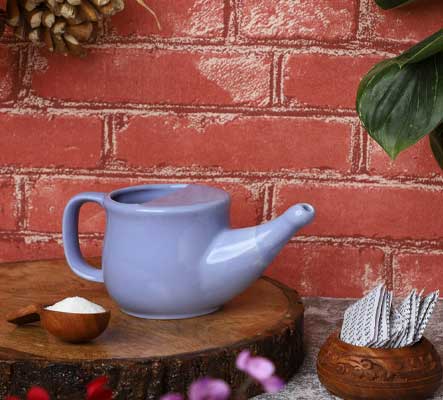Humans have been known to embrace and learn from nature during prehistoric times. They learnt their harshest survival lessons from Mother Nature and passed on this knowledge to the future generations. During a naval expedition, some coastal dwellers happened to observe that sniffing the salty ocean water in the palm during a cold or congestion in the nose made breathing easier and eased the congestion. This could have led to the discovery of the Neti pot as holding water in the palm was not a sustainable alternative. The first pictorial representation of a Neti Pot has been found on a temple wall which may have belonged to the 15th Century. Neti Pots were mostly used by Yoga teachers and students, spiritual seekers to prepare the body and mind for deep inhalation for prolonged meditative practices. This usage of Neti pots by Yoga teachers has been evidenced between the 11th to 15th century.
For more than 5000 years, Neti pots were in use as an integral and inseparable part of the Yogic tradition. Apart from Jala Neti, which is what a Neti pot is used for- Hatha Yoga masters taught other Neti practices like the Sutra Neti- which is the more advanced version of Neti where a thread or string is used to clean the nasal passage. A thin cotton thread of 4mm width is dipped in either honey or ghee and is inserted into the nostril to be taken out from the mouth. This is considered as a more thorough method of cleansing. The Sutra Neti is to be done only under expert Ayurvedic/Yogic supervision as it is a complex and advanced procedure.
Other Neti practices which were also seen are the Dugdha Neti Kriya and the Ghrita Neti Kriya. The Dugdha Neti Kriya is a yogic technique of cleaning the nasal passage with milk. Instead of salt and water which are used in a Neti Pot, the Dugdha Neti Kriya uses warm milk in a Neti Pot. It can also be done in combination with the Jala Neti Kriya by first rinsing the nasal passage with the saline water solution followed by the Dugdha Neti Kriya to soothe any irritated nasal passages as milk is a natural hydrator and moisturizer.


Like the name suggests, the Ghrita Neti Kriya uses warm ghee in a neti pot to perform the Neti Kriya. Apart from nasal irrigation, the Ghrita Kriya is also known to have psychological and spiritual benefits considering the importance of Ghee in Ayurvedic practices. When performed on an empty stomach first thing in the morning, the Ghrita Neti Kriya is known to irrigate the nasal mucosa and tear ducts. It relaxes the nervous system, contributes to glowing skin and restores vitality of the skin.
So, Neti Pots had been around for many centuries until the 1990’s when some medical practitioners started experimenting with it on themselves to test its efficacy. The results were superlative and astonishing. Until then, Neti Pots were endorsed only by the Ayurvedic fraternity and now it had gained medical approval too.
Neti pots were recommended by doctors to treat and prevent respiratory infections. This interest in the traditional technique suffered a mild setback with the discovery of penicillin by Alexander Flemins. Penicillin shot into the limelight as the miracle drug which became the base for many antibiotics. When people started using antibiotics in huge numbers, a natural resistance for these antibiotics was formed and the interest in natural methods of treating respiratory illnesses was revived. This brought back the humble Neti pot and other nasal irrigation techniques back into the foray.